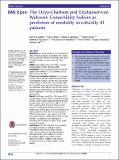| dc.contributor.author | Ladha, Karim S | en_US |
| dc.contributor.author | Zhao, Kevin | en_US |
| dc.contributor.author | Quraishi, Sadeq A | en_US |
| dc.contributor.author | Kurth, Tobias | en_US |
| dc.contributor.author | Eikermann, Matthias | en_US |
| dc.contributor.author | Kaafarani, Haytham M A | en_US |
| dc.contributor.author | Klein, Eric N | en_US |
| dc.contributor.author | Seethala, Raghu | en_US |
| dc.contributor.author | Lee, Jarone | en_US |
| dc.date.accessioned | 2015-10-01T14:57:28Z | |
| dc.date.issued | 2015 | en_US |
| dc.identifier.citation | Ladha, Karim S, Kevin Zhao, Sadeq A Quraishi, Tobias Kurth, Matthias Eikermann, Haytham M A Kaafarani, Eric N Klein, Raghu Seethala, and Jarone Lee. 2015. “The Deyo-Charlson and Elixhauser-van Walraven Comorbidity Indices as predictors of mortality in critically ill patients.” BMJ Open 5 (9): e008990. doi:10.1136/bmjopen-2015-008990. http://dx.doi.org/10.1136/bmjopen-2015-008990. | en |
| dc.identifier.issn | 2044-6055 | en |
| dc.identifier.uri | http://nrs.harvard.edu/urn-3:HUL.InstRepos:22857024 | |
| dc.description.abstract | Objectives: Our primary objective was to compare the utility of the Deyo-Charlson Comorbidity Index (DCCI) and Elixhauser-van Walraven Comorbidity Index (EVCI) to predict mortality in intensive care unit (ICU) patients. Setting: Observational study of 2 tertiary academic centres located in Boston, Massachusetts. Participants: The study cohort consisted of 59 816 patients from admitted to 12 ICUs between January 2007 and December 2012. Primary and secondary outcome For the primary analysis, receiver operator characteristic curves were constructed for mortality at 30, 90, 180, and 365 days using the DCCI as well as EVCI, and the areas under the curve (AUCs) were compared. Subgroup analyses were performed within different types of ICUs. Logistic regression was used to add age, race and sex into the model to determine if there was any improvement in discrimination. Results: At 30 days, the AUC for DCCI versus EVCI was 0.65 (95% CI 0.65 to 0.67) vs 0.66 (95% CI 0.65 to 0.66), p=0.02. Discrimination improved at 365 days for both indices (AUC for DCCI 0.72 (95% CI 0.71 to 0.72) vs AUC for EVCI 0.72 (95% CI 0.72 to 0.72), p=0.46). The DCCI and EVCI performed similarly across ICUs at all time points, with the exception of the neurosciences ICU, where the DCCI was superior to EVCI at all time points (1-year mortality: AUC 0.73 (95% CI 0.72 to 0.74) vs 0.68 (95% CI 0.67 to 0.70), p=0.005). The addition of basic demographic information did not change the results at any of the assessed time points. Conclusions: The DCCI and EVCI were comparable at predicting mortality in critically ill patients. The predictive ability of both indices increased when assessing long-term outcomes. Addition of demographic data to both indices did not affect the predictive utility of these indices. Further studies are needed to validate our findings and to determine the utility of these indices in clinical practice. | en |
| dc.language.iso | en_US | en |
| dc.publisher | BMJ Publishing Group | en |
| dc.relation.isversionof | doi:10.1136/bmjopen-2015-008990 | en |
| dc.relation.hasversion | http://www.ncbi.nlm.nih.gov/pmc/articles/PMC4563218/pdf/ | en |
| dash.license | LAA | en_US |
| dc.subject | EPIDEMIOLOGY | en |
| dc.title | The Deyo-Charlson and Elixhauser-van Walraven Comorbidity Indices as predictors of mortality in critically ill patients | en |
| dc.type | Journal Article | en_US |
| dc.description.version | Version of Record | en |
| dc.relation.journal | BMJ Open | en |
| dash.depositing.author | Quraishi, Sadeq A | en_US |
| dc.date.available | 2015-10-01T14:57:28Z | |
| dc.identifier.doi | 10.1136/bmjopen-2015-008990 | * |
| dash.contributor.affiliated | Kaafarani, Haytham | |
| dash.contributor.affiliated | Quraishi, Sadeq | |
| dash.contributor.affiliated | Lee, Jarone | |
| dash.contributor.affiliated | Eikermann, Matthias | |


